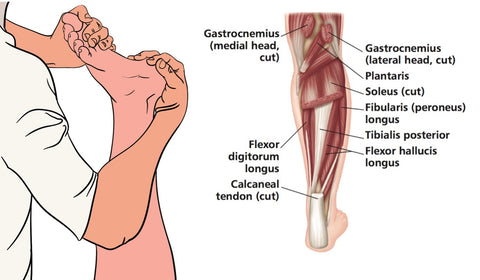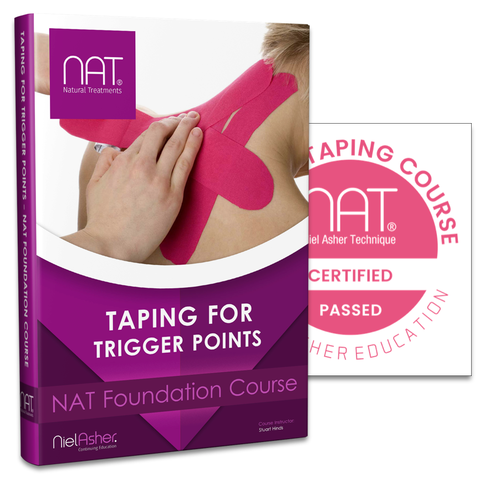Trigger Point Therapy - Taping for Plantar Fasciitis and Heel Pain
Taping for Plantar Fasciitis - Stuart Hinds
Trigger Point Therapy Online Master Course
One of the most common diagnosis of chronic heel pain is plantar fasciitis
The plantar fascia runs across the bottom of the foot and connects the heel bone to the toes.
This thick band of tissue can become inflamed causing a sharp pain, most commonly felt when the client stands first thing in the morning
In most cases, the pain subsides once the foot limbers up but then returns after long periods of standing or getting up after having been sitting with the weight off the feet for a prolonged period.
Plantar fasciitis often affects people who regularly run, jog or walk (30 mins plus per day), especially on hard surfaces.
Being overweight and badly fitting footwear, worn-out running shoes, or long periods spent standing whilst wearing high heels may also be a factor.
What's causing the pain and inflammation?
Under normal circumstances, the plantar fascia acts like a shock-absorber to support the arch in your foot.
When the tension on the shock-absorber becomes too great, it can create small tears in the fascia.
Over time, the repetitive stretching and tearing can cause the fascia to become irritated and inflamed.
Don't ignore it!
Many people tend to try to ignore the symptoms of plantar fasciitis, especially as the pain often subsides after a few minutes of walking around.
What happens in these situations is that people sometimes train themselves to walk slightly differently in order to take the pressure off the heel and thereby minimize the pain until it subsides.
This in turn may lead to the development of other foot, knee, hip or back problems.
Remember, in most cases plantar fasciitis can be effectively treated with a combination of trigger point therapy, strengthening, stretching, and taping.

Trigger Point Therapy
Plantar Fasciitis is typically associated with trigger points in the Gastrocnemius, Soleus, Plantaris, and Quadratus Plantae muscles.
Trigger point therapy protocols for treating plantar fasciitis are well known, autonomously reproducible, and are commonly practiced by trigger point professionals.
These trigger points are all pretty accessible and clients should be encouraged to work on them at home between treatments as part of a comprehensive treatment program.
This should usually include stretching, strengthening exercises, and often simple lifestyle changes.
Links
Find a Trigger Point Professional in your area
Dry Needling for Trigger Points
Certify as a Trigger Point Therapist
About NAT Courses
As a manual therapist or exercise professional, there is only one way to expand your business - education!
Learning more skills increases the services that you offer and provides more opportunity for specialization.
Every NAT course is designed to build on what you already know, to empower you to treat more clients and grow your practice, with a minimal investment in time and money.
Help Desk
NAMTPT AWARD
We are honored to have received the 2017 "Excellence in Education" Award from the National Association of Myofascial Trigger Point Therapists.
Since 1999 Niel Asher Education has won numerous awards for education and in particular for education and services provided in the field of trigger point therapy.
Read Full Article
About Niel Asher Education
Niel Asher Education is a leading provider of distance learning and continued education courses.
Established in the United Kingdom in 1999, we provide course and distance learning material for therapists and other healthcare professionals in over 40 countries.
Our courses are accredited by over 90 professional associations and national accreditation institutions including the National Academy of Sports Medicine (NASM) and National Certification Board for Therapeutic Massage and Bodywork (NCBTMB). Full details of all international course accreditations can be found on our website.
Printed course materials and other products offered on our websites are despatched worldwide from our 3 locations in the UK (London), USA (Pennsylvania) and Australia (Melbourne).
More About Us
NAT Certification
If you are a qualified/licensed manual therapist or exercise/fitness professional you can expand your credentials with NAT certification.
In addition to national accreditation for continued education, each course that we offer includes "NAT Learning Credits". By taking and completing courses you can accumulate NAT credits to qualify for NAT certification.
There are currently 3 levels of NAT certification. Certifying NAT is a valuable way to show your clients that you take continued education seriously, and to promote your skills and qualifications.
About NAT Certification
Niel Asher Technique
Since 1999 the Niel Asher Technique for treating trigger points has been adopted by over 100,000 therapists worldwide, and has been applied to the treatment of a number of common musculoskeletal injuries.
The Niel Asher Technique for treating frozen shoulder was first introduced and published in 1997 and has been widely adopted by therapists and exercise professionals working within elite sports and athletics.
Read More
This trigger point therapy blog is intended to be used for information purposes only and is not intended to be used for medical diagnosis or treatment or to substitute for a medical diagnosis and/or treatment rendered or prescribed by a physician or competent healthcare professional. This information is designed as educational material, but should not be taken as a recommendation for treatment of any particular person or patient. Always consult your physician if you think you need treatment or if you feel unwell.
About Niel Asher Education
Niel Asher Education (NAT Global Campus) is a globally recognised provider of high-quality professional learning for hands-on health and movement practitioners. Through an extensive catalogue of expert-led online courses, NAT delivers continuing education for massage therapists, supporting both newly qualified and highly experienced professionals with practical, clinically relevant training designed for real-world practice.
Beyond massage therapy, Niel Asher Education offers comprehensive continuing education for physical therapists, continuing education for athletic trainers, continuing education for chiropractors, and continuing education for rehabilitation professionals working across a wide range of clinical, sports, and wellness environments. Courses span manual therapy, movement, rehabilitation, pain management, integrative therapies, and practitioner self-care, with content presented by respected educators and clinicians from around the world.
Known for its high production values and practitioner-focused approach, Niel Asher Education emphasises clarity, practical application, and professional integrity. Its online learning model allows practitioners to study at their own pace while earning recognised certificates and maintaining ongoing professional development requirements, making continuing education accessible regardless of location or schedule.
Through partnerships with leading educational platforms and organisations worldwide, Niel Asher Education continues to expand access to trusted, high-quality continuing education for massage therapists, continuing education for physical therapists, continuing education for athletic trainers, continuing education for chiropractors, and continuing education for rehabilitation professionals, supporting lifelong learning and professional excellence across the global therapy community.

Continuing Professional Education
Looking for Massage Therapy CEUs, PT and ATC continuing education, chiropractic CE, or advanced manual therapy training? Explore our evidence-based online courses designed for hands-on professionals.




















